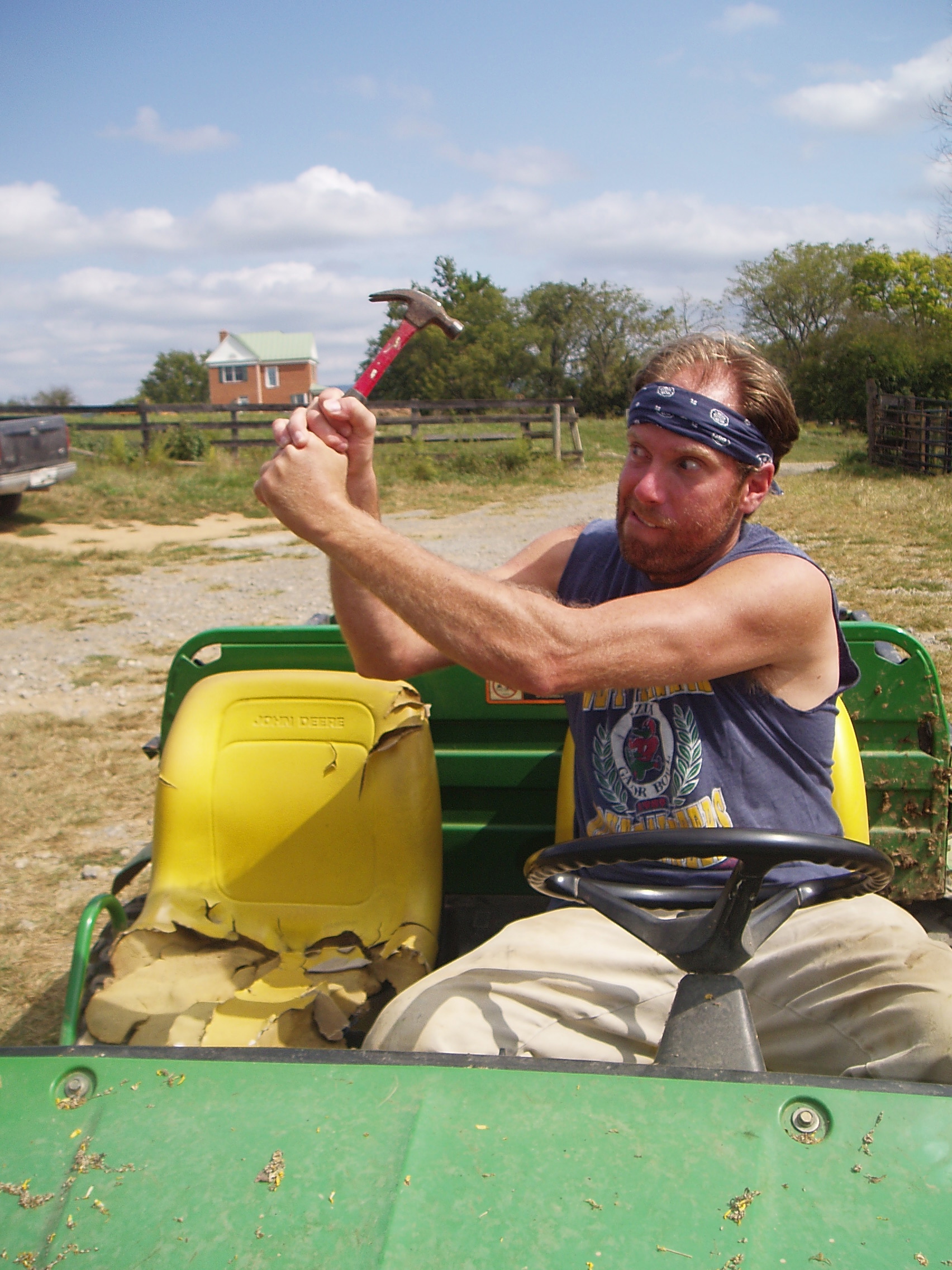
A dawn view on our farm in Clarke County, Virginia. West Virginia’s Blue Ridge mountains are in the distance.
For years, a baker friend of mine at farmers market had been selling lamb. Why would John, who made pumpernickel bread for a living, also be in the lamb chop business? To help out an old sheep-farming friend in Montana, John had gone out of his way to build a legion of lamb lovers in his own hometown, Washington D.C. Once a year, his farmer friend processed and shipped sausages and chops across the country, and John sold them to his local customers. It was an unusual pairing, to be sure, but one that was profitable for both of them.
One morning at farmers market, John approached me with an idea. “Wouldn’t it make more sense for you to be selling this lamb instead of me? You’ve got the refrigeration. Plus, it’s a natural fit with the free-range pork and beef you’re already bringing to market.”
This was about thirteen years ago, before I started raising sheep in earnest, and the idea of offering lamb to my customers was certainly intriguing. To make the transition even easier, John said he would happily turn over his customer list to me.
I called his friend in Montana, and we immediately struck up a pleasant conversation. In the end, the deal was this: the farmer would sell me 25 lambs, each 100 pounds live weight, and have them processed and shipped to me. I would pay $200 per lamb (this included processing), plus the cost of trucking. Since 35 pounds of meat was a standard expectation from a 100 pound lamb, at $10/lb, I would gross $8750. Minus expenses of $5,000 (plus shipping), the profit would be around $3,500.
In my twenty-five year old mind, I felt sure this was a ‘can’t-miss’ opportunity. After all, what could possibly (insert sarcasm here) go wrong with shipping 25 boxes of lamb from Montana to Virginia?
Things went downhill from the start. When the refrigerated truck arrived a few weeks later, it only carried eight 50 pound boxes. I figured there had to be some kind of mistake, but I was his last stop, and the truck was now empty. The driver requested a C.O.D. for $400. I wrote him a check, then sat down to do some math.
At 35 pounds per animal, I should have received over 800 pounds of lamb. Yet, as I unpacked the boxes, only 350 pounds had been delivered, including heavier bone-in cuts such as legs, shanks and soup bones. According to this, each of the 100 pound lambs had only yielded 15 pounds of meat. Something wasn’t right.
A few hours later, I had the farmer on the phone, and explained the situation.
“I bet I know what happened,” he explained. “I was away the last few weeks, and my daughter loaded the lambs that day. Sometimes she gets in a hurry and doesn’t count very carefully. I’ll talk to her and call you back.”
Fabulous, I thought to myself. Now a third person was in the mix, someone who may or may not have counted all the sheep. This should be interesting.
The next day, the farmer called me back. “I talked to my daughter. She said she’s pretty sure it was twenty five.”
“‘Pretty sure’?” I repeated, as diplomatically as I could. “Uhh… what does that mean?”

Pig carcasses, chilling in my butcher’s cold storage. Because I load and transport our animals myself, it’s a lot easier to understand how they go from this…
“Well, I think we can trust her,” he insisted, though a note of uncertainty had crept into his voice. “Besides, there’s nothing we can do about it now.”
Nothing we could do? I suggested checking the farm records.
“I already thought of that,” the farmer said. “But we had a coyote come through around that time, and now we’re not sure which ones went to the butcher, and which ones the coyote might have carried off. Maybe you should call the butcher, and ask him how many he processed.” The man paused, and cleared his throat. “By the way. When should I expect my check for $5,000?”
Wait a minute. Why was I supposed to call his butcher? And why did he expect me to pay before the situation had been settled? In the end, I convinced him to call the butcher himself, and get further clarification.
A week went by, then two, and I didn’t hear anything. Then, I received an e-mail (names changed for anonymity):
Hello Forrest,
This is farmer Joe’s wife, Mary. I’m an attorney here in Montana. We would really hate to press charges on another farmer, but you’re leaving us little choice. Please pay us the $5,000 you owe us immediately.
Best regards,
Mary Shepherd
Well, that got my blood pressure soaring! I was on the phone in seconds.
“Hello? Joe? What did you find out from the butcher? I just got an e-mail from your wife…”
“Yeah,” he said, interrupting me. His voice was decidedly cool. “I spoke to the butcher, and he said he sent you everything. Now, look. Try to see things from my perspective. You’re all the way across the country, and you’ve got $5,000 dollars worth of my lamb. How can I be sure that you’re not the one who’s trying to bamboozle me? There’s no way of knowing if you’ve got more lamb than you claim.”
I was absolutely flabbergasted by this line of reasoning. “But… but… why would I do that? I’m just trying to figure out what happened. I mean, if it made you feel better, I could get John to count it…”
“No, no,” he cut me off again. “No need to get John mixed up in this. Just pay me my money, and we’ll be willing to call it even.”
In the end, I realized I was mired in a ‘he said, she said,’ kind of dialogue. Begrudgingly, I wrote the check for $5,000, and sent it off to them. When all was said and done, I lost over two thousand dollars on the deal.
So, what was my mistake, exactly? It certainly wasn’t just about the money, or taking a risk, or trusting my fellow producer. No, my error was this: instead of being a farmer—the person who actually grows the food he sells—I had detoured into something else entirely: I had become a middleman. By taking a 2,000 mile shortcut, I had not only outsourced my ability to control quality and oversight, but I had also placed my personal happiness and job satisfaction on the line.
If this episode in a young farmer’s life doesn’t sound like much of a ‘big deal’, then take a moment and apply it to our current national food system (especially with regard to the stampede of organic and local food currently being rushed into the marketplace). Do you ever wonder how the enormous, multi-million dollar restaurants and supermarkets can maintain quality and oversight with supply chains that stretch for thousands upon thousands of miles? In the gap between farm and table, an army of middlemen exists whose job it is just to oversee all the other middlemen.

Sometimes, I still just want to hit myself in the head with a hammer. You probably know the feeling.
It reminds me of a nationwide supermarket campaign a few years back: Our produce is inspected 5 times before it makes it to our store… quality is job #1. Each time I heard this advertisement, I rolled my eyes. What happens behind the scenes that food needed to be inspected 5 separate times? In my own case, at least three different inspections would have been needed to make sure the lamb was delivered as promised.
These days, the food that comes from our farm only needs to be inspected once: when it is harvested it from our fields. The next stop is straight to farmers market. This is food at its best, at its freshest and most local. As we come full-circle and reconnect with our seasonal agrarian roots, I feel grateful to have made an encyclopedia’s worth of mistakes so far in my career. It’s by learning from mistakes such as these—painful as they may be—that small farms like ours are steered onto the path of sustainability we’ve always dreamed of.
**Quick Update** I’ve gotten several comments elsewhere suggesting if I had only “checked the invoice and rejected the order” then this would have never happened. While that’s technically true, it misses one of the larger points of the story: that our current system of long-distance food supply is fraught with potential error. These mistakes can be reduced or eliminated by focusing on local production, and with farmers like myself staying true to their mission statement.











This “deviation” from farming to fields in which farmers usually have limited expertise at best sent a lot of farmers into bankruptcy in the 1980s. Many allowed themselves to be seduced into thinking that they were financiers, and lost their farms in the process when they attempted to leverage their assets into big money.
Also, during this unhappy time of widespread bankruptcies and farm failures it seemed that the more high tech the farm, the sooner it went on the auction block. Simple farming. carried out well, will carry the day.
Michael,
Very insightful response. I often feel that successfully raising one species of animal on the farm (i.e., having 1 enterprise) is worthy of a career unto itself, without any further ‘deviations’. On our farm, we raise 4 different kinds, and it’s certainly a handful. With the amount of specialization that’s required, it’s really foolish to believe that shortcuts could be taken in the pursuit of additional ‘deviations’.
In this case, I was able to learn from my mistake; the (relatively) low financial cost allowed me to more or less lick my wounds and move on. Certainly not the case for everyone. I failed ‘small’. As you mention, many farms in the 80s failed ‘big’. For better or for worse, I grew up on one of those farms, and witnessed first hand how close our own farm came to failing big during that decade. It’s probably been a subtle influence on how I operate.
I’m a wannabe small farmer. I’ve raised and sold some meat birds but that’s it for now due to some life constraints. Being recently from the city though I have a network of people clamoring for fresh, well-raised meat. I’m also gaining a network of farmers I trust and so I’m now doing some small scale brokering. It’ll work out that my family will eat beef this year for free but maybe it’s just the scale of the deal I’m doing that reduces the risk. Or the fact that I’m dealing with a local farmer who I’ve met in person. I don’t know, but I do know there’s an appetite out there for well raised meat and if I can’t raise it myself, at least I can source and sell it in an arrangement where everyone wins. It’s too bad you were taken on that deal but a good heads up as the person currently in the middle.
Thanks, Sarah. Yes, feel free to view this as a cautionary tale. Without adding to what was already a long blog, some additional takeaways from my mistake are these:
1) Never assume that your suppliers will deliver flawlessly every time. Relationships (and trust) take time to build. A lot can get lost in what might otherwise seem like simple communication.
2) Don’t trick yourself into thinking that you can diversify your expertise quickly, or outsource it to another producer. You’ll find yourself building a house of cards, when instead you need to be focusing on quality and production. In other words, be a farmer, not a middleman!
3) You’re not doing anyone a favor by rushing product to market if you end up stressing yourself out, or absorbing too much financial risk. Better to pass on an opportunity than to screw it up because you sacrificed oversight and quality. It’s almost impossible to get a customer back after you’ve lost them.
Okay, thank goodness for the comments section! I’ve yet to write a blog where I express everything I wanted to the first time 😛
You tell a great story. Point well taken.
I was surprised no one raised a ruckus about John selling something from so far away before he got to you, even if it was a ‘friend’. Surely they have farmers’ markets in Montana. My farmer here in WI buys some wholesale, but it’s still from local farmers. And since my farmer’s been at it for 50 years, he’s pretty saavy about who he buys from. And he almost always pays a little more than what they ask if it’s good quality organic because he knows that farmers deserve a fair price.
Can’t wait to read your book!
Hi Rose,
Good point, I should clarify that. John had a storefront in Maryland where he sold the lamb; he didn’t actually sell it at farmers market. I ended up selling it directly to his customers in D.C., so it never ended up at a ‘producers only’ farmers market.
Thank you for the kind words! The book is currently available for pre-order on Amazon HERE, and hits the shelves in May.
I’m sorry for your bad experience with that. If the shipping slip said 400 pounds, that’s all you should have paid for. Oh well, I’m sure you’re over it by now. It’s just upsetting to read about. I’m looking forward to checking out your new book!
[…] what he describes as “The Biggest Mistake I Ever Made as a Farmer,” Pritchard tells the rest of the story and shares a lesson he learned that can help us all be […]